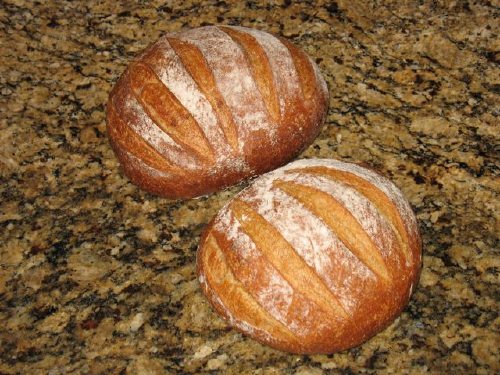When people think of sourdough starter lineages they often think of the famous San Francisco or Alaska starters originally brought over from Europe. I imagine the people who brought starters along with them were courageous people looking for a better life. I imagine they dehydrated their starters in the old country and carried small amounts of it in pouches or tiny clay pots carefully tucked into whatever belongings they could carry with them in the boats. When they got to the land of opportunity it is said their bread starters took on a new flavor, the flavor of their new locale. Hence the famousness of the San Francisco or Alaska sourdough flavors.
I first learned to make sourdough using an old-fashioned 7-day rye bread recipe. It was a goopy, no-knead recipe that produced a rich, malty, dense loaf. The starter was built over seven days, yielding a giant bowl of sponge-like starter. When it was time to assemble the breads rye flour, water and salt were incorporated into the starter. This “goop” was then spooned into the loaf pans as this bread did not stand up by itself, it needed “walls” to hold it up. It was so sticky that the less handling involved, the better the finished product.
When I began to work with gluten-free starter possibilities I used this spongy, goopy technique as a guide and after a year of many failures, had great success while incorporating a few important changes through trial and error:
- extra daily feedings to prevent spoilage
- boosting and preserving it with a bit of an old fashioned fermented drink, water kefir.
I found the starters to be rather delicate and did not regularly store well. I found that I could easily begin a new starter so using it up was never a problem. In fact, I found the fresh starters resulted in breads having a consistently fresh taste while the stored refrigerated starters often carried some “off tastes” I associated with over-fermentation. The over-fermentation also seemed to result in less than satisfactory leavening.
This sponge-goop technique is very different than wheat sourdough techniques that benefit from extensive kneading and shaping. Unlike their rye counterparts traditional wheat breads also stand up, rise and bake without the support of the walls of a loaf pan.
Some seasoned wheat sourdough bakers have had poor success with my technique when they apply their years of experience with wheat sourdough to my rice starter. They expect to take a small amount of starter and knead large amounts of flour into it, shape it, let it rise and bake it. My technique, however, is the opposite. I grow a large amount of high-moisture starter by feeding it at least twice a day. I then stir in a small amount of flour and pour or spoon it into a loaf pan or muffin tin. From there I let it rise and then bake it.
I think the main reason the wheat technique doesn’t work for my recipes is that my technique was originally derived from the 7-day sourdough rye sponge-goop technique which is really quite different than the wheat technique.
One definition of lineage is “the descendants of one individual”. The descendants of the San Francisco and Alaska sourdough starters are available for sale and supposedly retain some of that “genetic” material referring to the local bacteria and yeasts that grow in the starter. When one purchases those starters they know the lineage of their starter.
I don’t sell starters, I sell a technique. I think about my technique as a “technical” lineage, much like a technique or practice handed down from teacher to student, or master to apprentice. My “technical lineage” is a descendent of the 7-Day Sourdough Rye Technique.
I am deeply grateful for the people willing to try my technique because in addition to feeding ourselves we are also keeping alive a technique that could easily be forgotten in these modern times. We keep it alive by learning it, practicing it, feeding our families with it and teaching it to others.
We successfully unite the past with the future when we reclaim an old-fashioned technique like 7-day rye sourdough and successfully and palatably use it to address the modern dietary challenges of gluten intolerance.






 Than
Than
